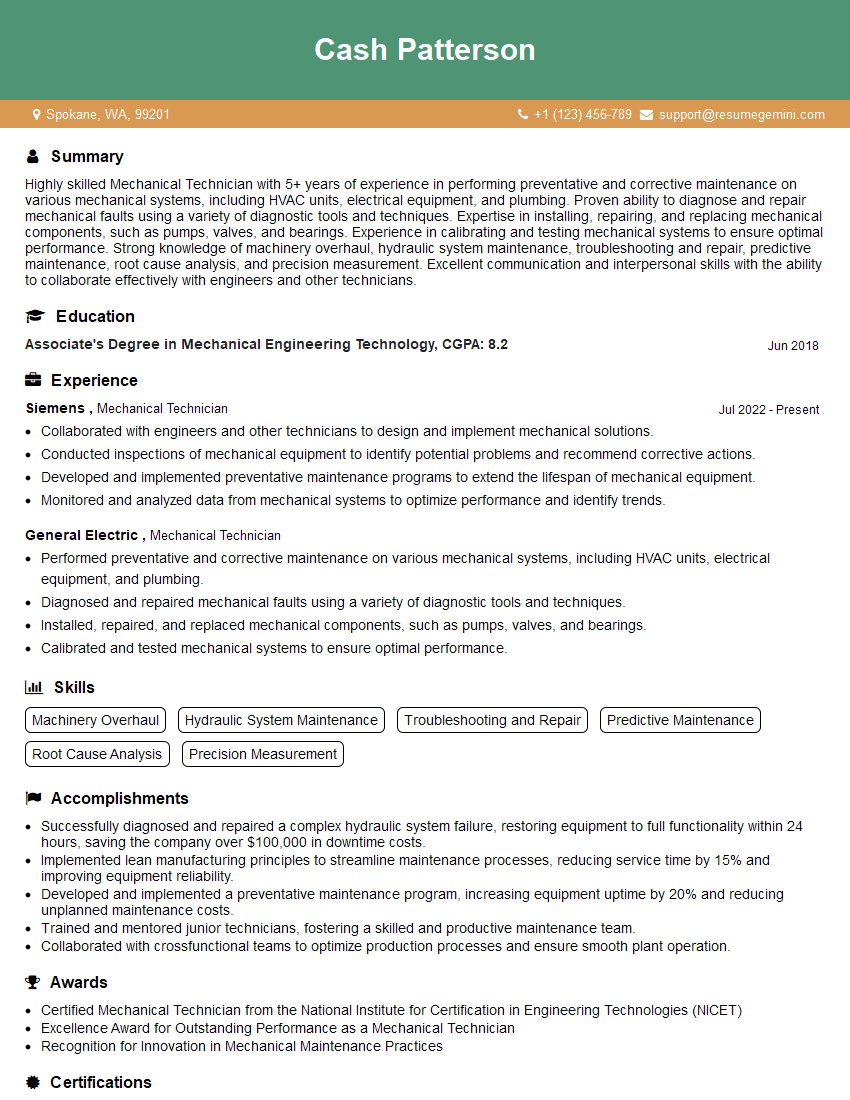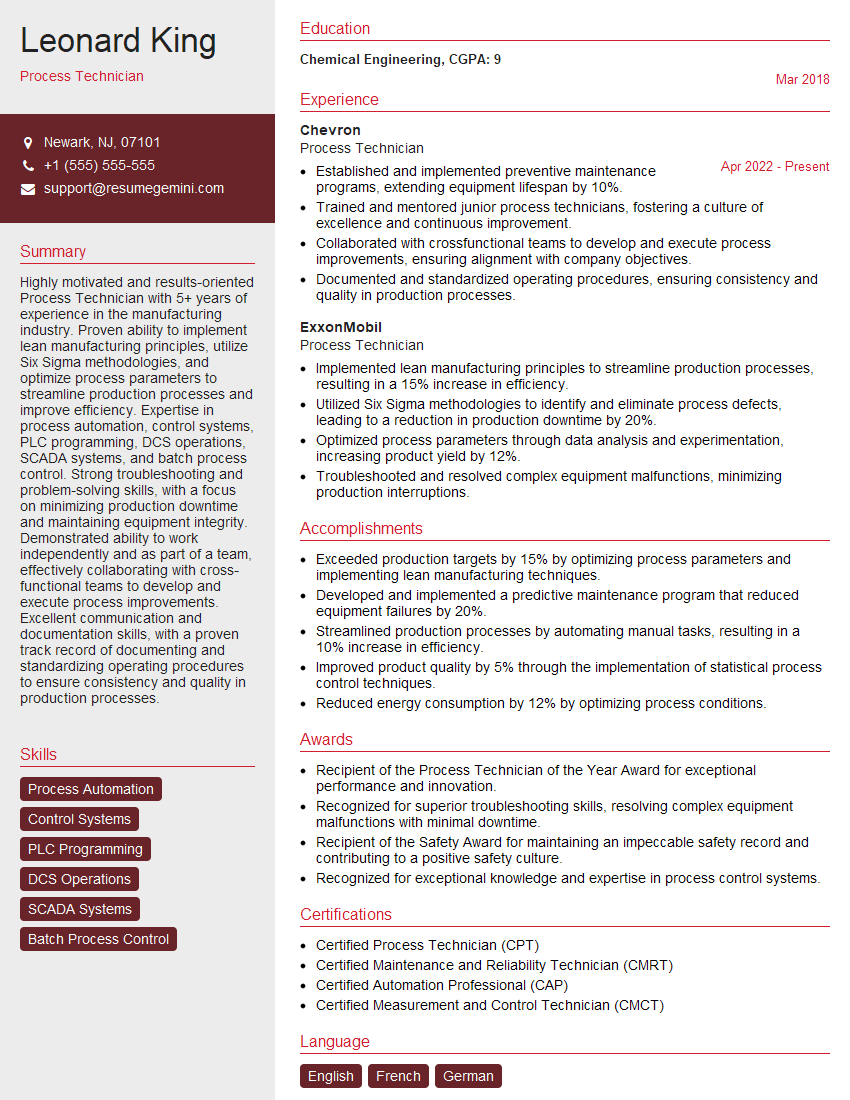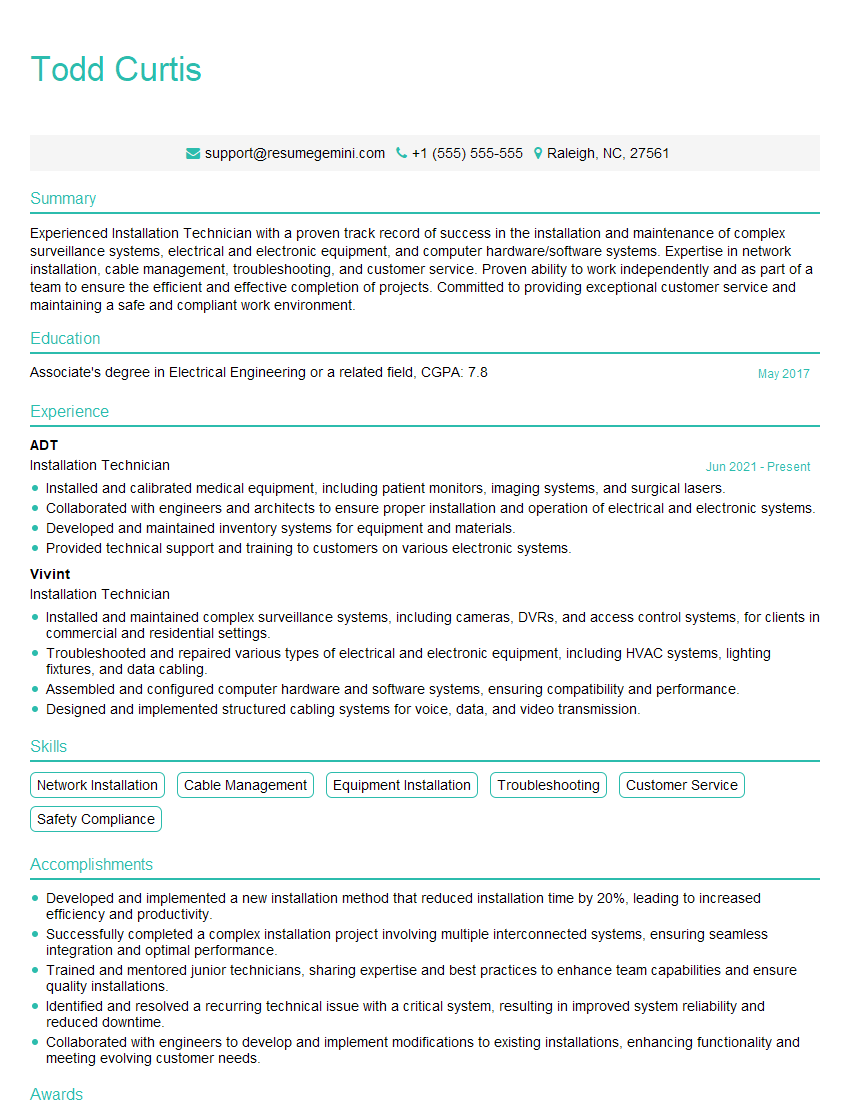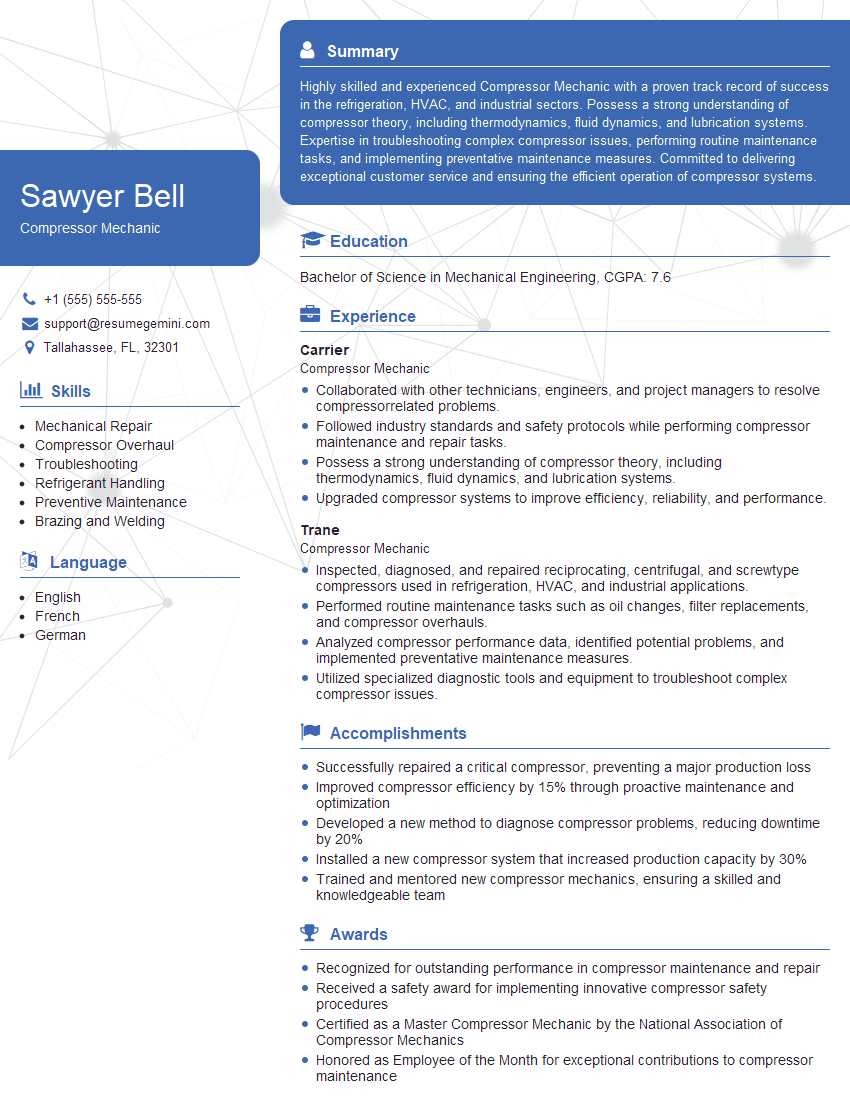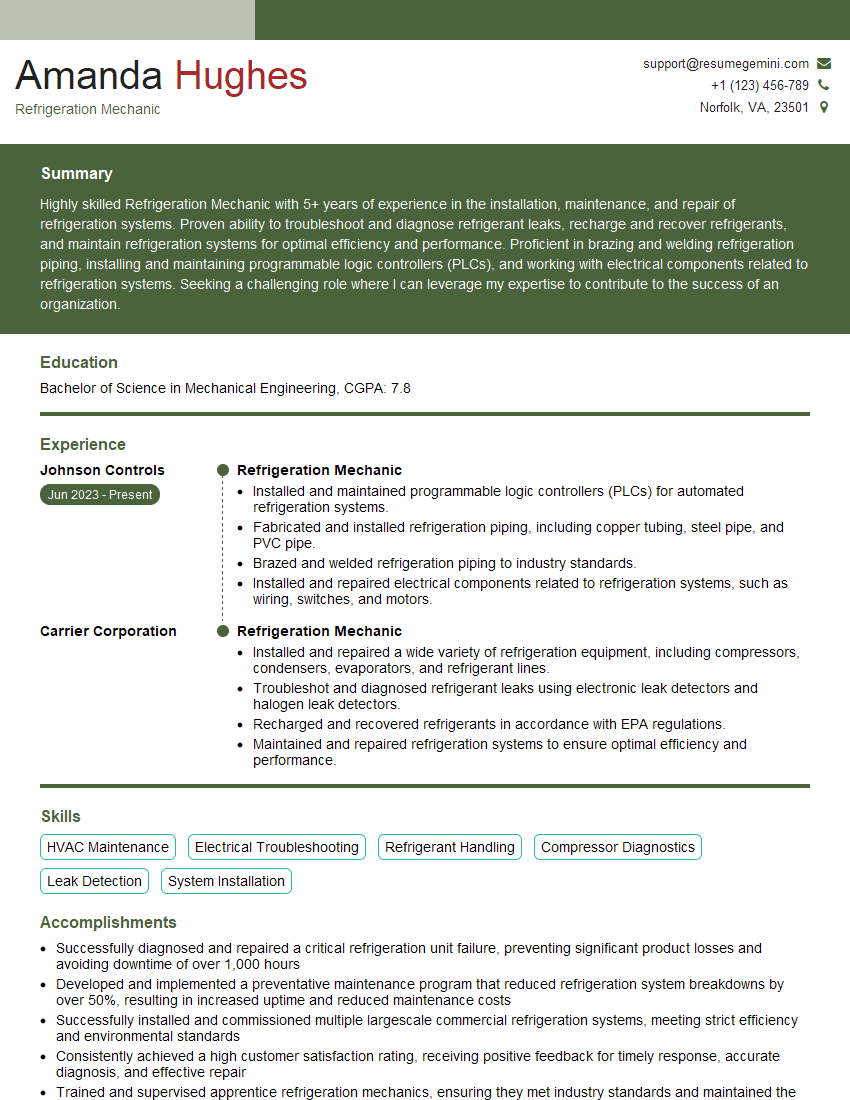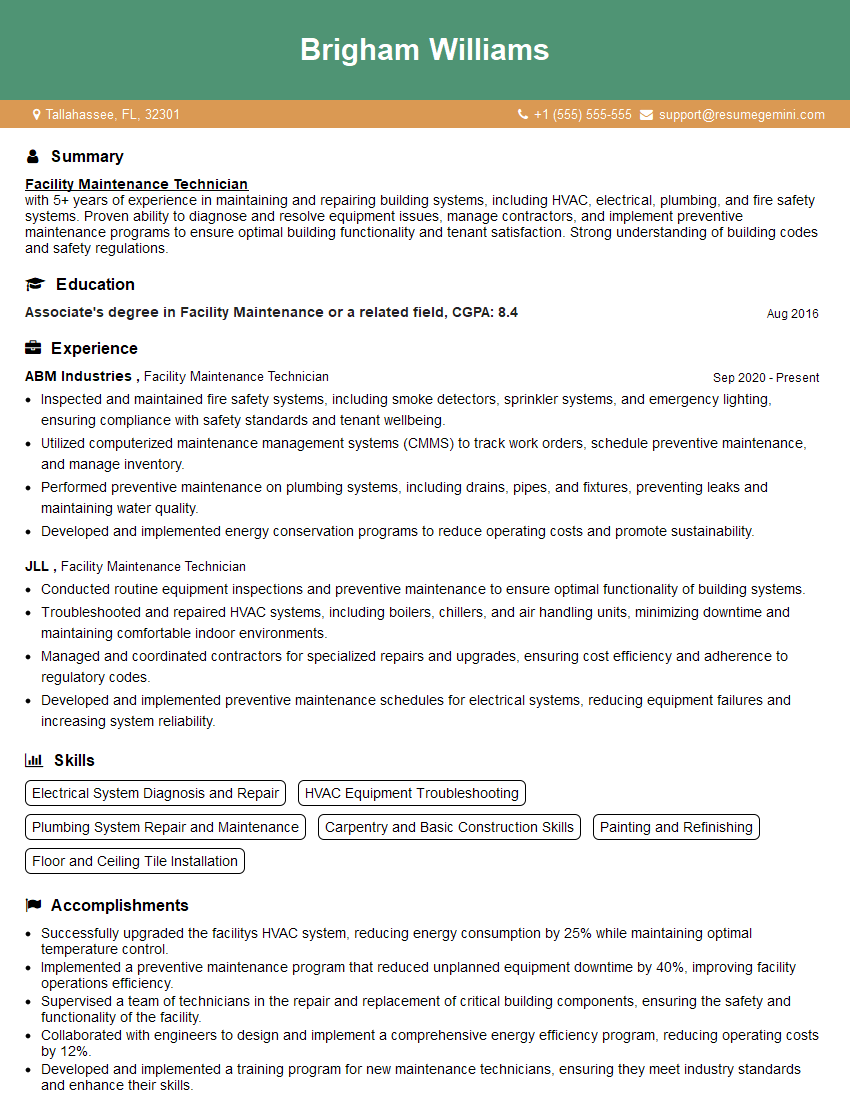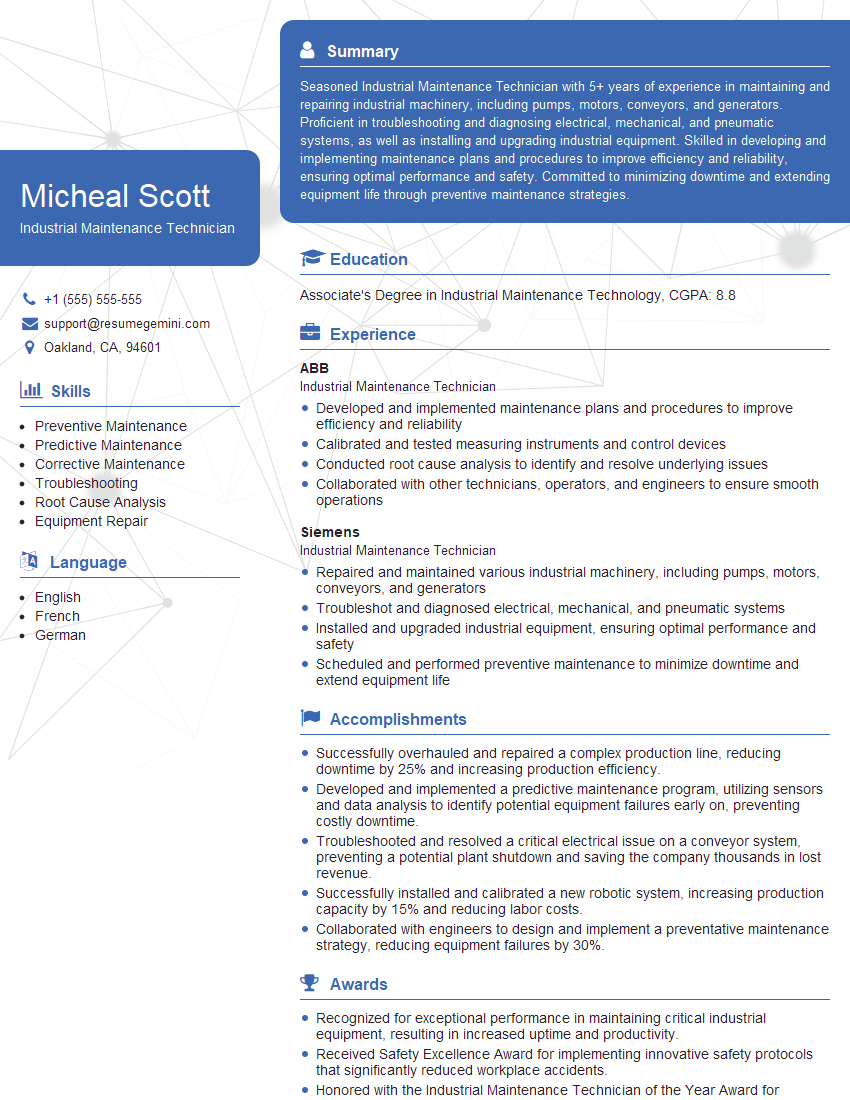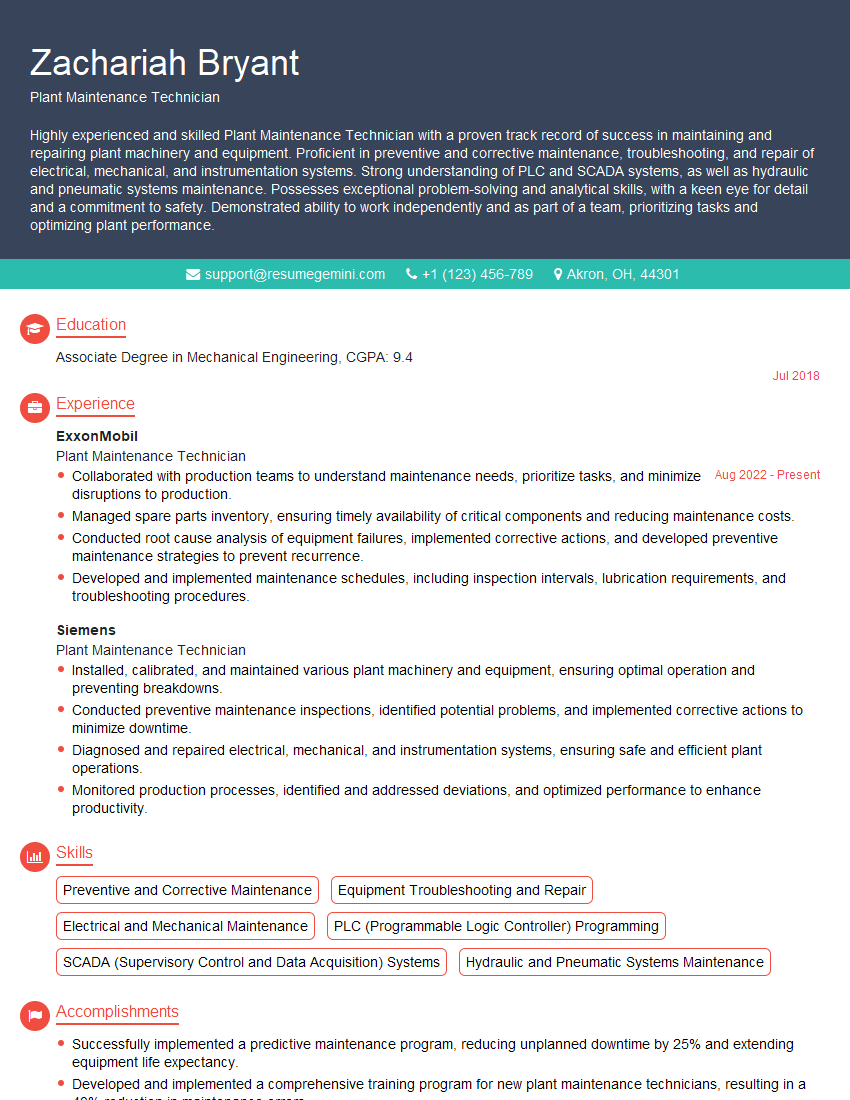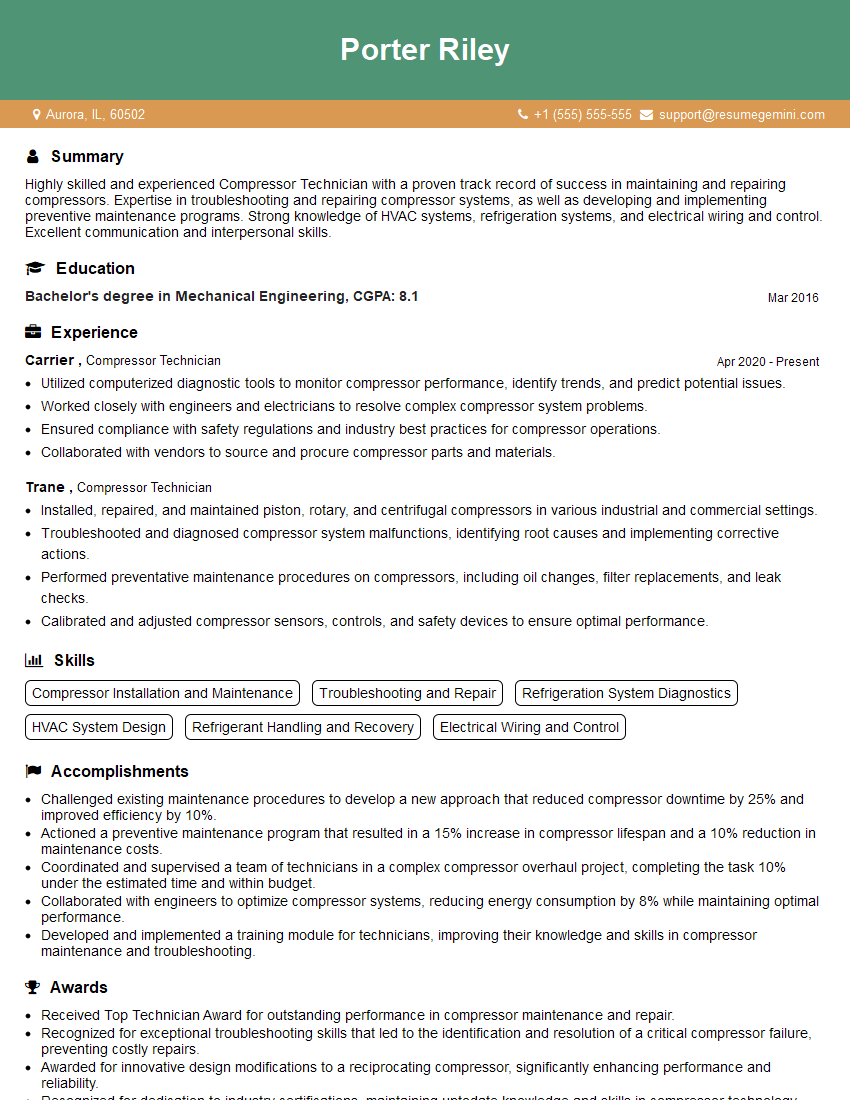Cracking a skill-specific interview, like one for Compressor Installation and Maintenance, requires understanding the nuances of the role. In this blog, we present the questions you’re most likely to encounter, along with insights into how to answer them effectively. Let’s ensure you’re ready to make a strong impression.
Questions Asked in Compressor Installation and Maintenance Interview
Q 1. Explain the different types of compressors.
Compressors are broadly categorized based on their compression mechanism. Understanding these differences is crucial for selecting the right compressor for a specific application.
- Reciprocating Compressors: These use pistons moving back and forth in cylinders to compress gas. Think of them like a supercharged bicycle pump. They’re known for high pressure capabilities but can be less efficient than other types at higher flow rates. Common in smaller industrial settings and some HVAC systems.
- Rotary Screw Compressors: Two helical rotors intermesh to compress the gas. Imagine two corkscrews working together. These are very reliable and efficient, especially at higher flow rates, making them popular in larger industrial settings and manufacturing plants.
- Centrifugal Compressors: These use rapidly spinning impellers to accelerate and compress the gas. Think of a fan pushing air, but on a much larger scale and at higher pressures. They’re efficient at very high flow rates but are usually better suited for high-volume, lower-pressure applications.
- Scroll Compressors: Two spiral-shaped scrolls rotate against each other, trapping and compressing the gas. They’re quiet and compact, often used in air conditioning and refrigeration systems.
- Diaphragm Compressors: These use a flexible diaphragm to compress the gas. They are often chosen for applications requiring a very clean, oil-free compressed air stream, such as in food processing.
The choice of compressor type depends heavily on factors such as required pressure and flow rate, budget, maintenance needs, and the specific application. For example, a large manufacturing plant might opt for a rotary screw compressor due to its high efficiency and capacity, while a small workshop might prefer a reciprocating compressor for its lower initial cost.
Q 2. Describe the process of installing a reciprocating compressor.
Installing a reciprocating compressor is a multi-step process requiring careful planning and execution to ensure safe and efficient operation. Safety is paramount throughout the entire process.
- Site Preparation: This includes ensuring a level and stable foundation, sufficient ventilation, and proximity to power and compressed air lines. The location should also account for noise levels and potential vibration.
- Mounting: The compressor is securely mounted onto the foundation using appropriate fasteners and vibration dampeners. Improper mounting can lead to premature wear and tear.
- Piping and Connections: All air intake and discharge lines are connected, ensuring proper sealing and leak-free connections. This includes using appropriate fittings and gauges to monitor pressure.
- Electrical Connections: The compressor is connected to the power supply, adhering strictly to electrical codes and safety regulations. Proper grounding is crucial to prevent electrical shocks.
- Testing and Commissioning: Before full operation, the compressor undergoes thorough testing to ensure proper functionality and leak-check. This includes checking pressure, temperature, and oil levels.
- Documentation: All installations steps, including dates, components used, and any modifications, are meticulously documented for future reference and maintenance.
For example, a poorly installed reciprocating compressor might vibrate excessively, leading to damage to the mounting, surrounding structures, or even failure of the compressor itself. Proper installation practices are essential for longevity and safety.
Q 3. How do you troubleshoot a compressor that is not producing sufficient pressure?
Troubleshooting insufficient pressure involves a systematic approach, eliminating possibilities one by one. Start with the simplest checks before moving to more complex diagnostics.
- Check Intake Air Filter: A clogged filter restricts airflow, reducing the compressor’s ability to generate pressure. Cleaning or replacing it is often the solution.
- Inspect Pressure Switch: A faulty pressure switch might not be turning the compressor on when needed or shutting it off at the correct pressure. Test the switch with a multimeter.
- Examine Safety Valves: If safety valves are stuck open, they’ll prevent the build-up of sufficient pressure. Test their functionality.
- Check for Leaks: Leaks in the piping or connections significantly reduce pressure. Use soapy water to identify leaks.
- Inspect Unloader Valve: If the unloader valve is malfunctioning, it might not be allowing the compressor to build pressure properly. Check for proper operation.
- Verify Oil Level and Condition: Low oil levels or contaminated oil can reduce performance. Check the oil level and condition. If necessary, perform an oil change.
- Analyze Pressure Gauge: Ensure the pressure gauge is functioning accurately and hasn’t failed.
A methodical approach ensures you pinpoint the problem efficiently. For example, a seemingly low pressure issue could actually be a faulty pressure gauge, rather than a mechanical problem with the compressor itself.
Q 4. What are the common causes of compressor overheating?
Compressor overheating is a significant concern, leading to reduced efficiency, damage, and even safety hazards. Several factors can contribute to this problem:
- Insufficient Cooling: Inadequate airflow around the compressor, due to obstructed vents or a dirty cooling system, prevents heat dissipation.
- High Ambient Temperature: Operating in high ambient temperatures makes it harder for the compressor to dissipate heat.
- Low Oil Levels: Oil lubricates and cools internal components. Low oil leads to increased friction and overheating.
- Clogged Air Filters: Restricted airflow increases the compressor’s work, leading to increased heat generation.
- Overloading: Demanding more compressed air than the compressor is designed for results in overheating.
- Malfunctioning Valves: Stuck or malfunctioning valves disrupt the compressor’s operation, leading to extra work and heat buildup.
- Internal Component Wear: Worn bearings or pistons cause increased friction and heat generation.
Regular maintenance, proper ventilation, and avoiding overloading are key to preventing compressor overheating. For example, ensuring adequate airflow around the compressor might simply involve cleaning accumulated dust and debris from the cooling fins.
Q 5. Explain the importance of oil lubrication in compressors.
Oil lubrication is vital for the proper functioning and longevity of a compressor. It plays several critical roles:
- Lubrication: Oil reduces friction between moving parts, minimizing wear and tear. Think of it as the lifeblood of the compressor’s internal components.
- Cooling: Oil absorbs and dissipates heat generated during the compression process, preventing overheating.
- Sealing: Oil helps seal the clearances between moving parts, preventing air leaks and maintaining efficiency.
- Cleaning: Oil helps keep the internal components clean, reducing wear and preventing the accumulation of contaminants.
Neglecting oil lubrication leads to rapid component wear, overheating, and ultimately, catastrophic failure. Regular oil changes and monitoring of oil levels are crucial preventative maintenance tasks.
For instance, imagine a car engine running without oil—the consequences are disastrous. Similarly, a compressor deprived of proper lubrication will quickly fail.
Q 6. Describe the different types of compressor valves and their functions.
Compressor valves are critical for controlling the flow of gas during the compression cycle. Different types are used depending on the compressor design and application.
- Reed Valves: These are simple, spring-loaded, thin metal flaps that open and close with the pressure differential. They are commonly found in reciprocating compressors due to their simplicity and cost-effectiveness.
- Plate Valves: These consist of a flat plate with openings that are covered and uncovered by the motion of the piston or other moving parts. They are a more durable alternative to reed valves.
- Ball Valves: These use a ball to control the flow of gas. While less common in compressors than reed or plate valves, they can be used in certain applications.
The function of the valve is to allow the gas to flow into the cylinder during the intake stroke and prevent it from flowing back during the compression stroke. Valve failure can lead to reduced efficiency, increased wear and tear, and ultimately, compressor failure. Regular inspection and maintenance are necessary to prevent problems.
Q 7. How do you perform a compressor oil change?
Performing a compressor oil change is crucial for maintaining its efficiency and lifespan. It’s a relatively straightforward procedure, but safety precautions must be followed.
- Safety First: Before starting, ensure the compressor is completely turned off and depressurized. Allow sufficient time for the compressor to cool down.
- Drain the Old Oil: Locate the oil drain valve or plug and carefully drain the old oil into a suitable container. This might involve using a wrench to loosen the drain plug.
- Remove Oil Filter (if applicable): If there is an oil filter, remove and replace it with a new one of the same type.
- Refill with New Oil: Consult the compressor’s manual to determine the correct type and quantity of oil. Add the new oil through the oil fill port.
- Check Oil Level: Once filled, check the oil level using the dipstick, ensuring it’s within the recommended range.
- Start and Monitor: Start the compressor and monitor the oil pressure and temperature. Check for any leaks.
Regular oil changes, at intervals specified in the compressor’s manual, are essential to keep the compressor running smoothly. Using the wrong type of oil can severely damage the compressor.
For example, neglecting oil changes will lead to sludge buildup, which reduces lubrication and cooling, causing premature wear.
Q 8. What safety precautions should be taken when working with compressors?
Working with compressors involves significant safety risks due to high pressures, moving parts, and potential for hazardous materials. Before commencing any work, always ensure the compressor is completely shut down and depressurized. Lockout/Tagout procedures are crucial to prevent accidental startup. This involves physically locking the power switch to prevent operation.
- Personal Protective Equipment (PPE): Always wear safety glasses, hearing protection, and sturdy work boots. Depending on the task, gloves and a respirator may also be necessary.
- Proper Ventilation: Compressors can release hot air and potentially harmful gases. Ensure adequate ventilation in the work area to avoid overheating or inhalation hazards.
- Awareness of High-Pressure Systems: Never work on a pressurized system. Always relieve pressure before performing any maintenance or repairs. Never attempt to repair or modify a compressor without proper training and understanding of its components.
- Fire Prevention: Compressors often use oil-based lubricants which present a fire hazard. Keep flammable materials away from the compressor, and have a fire extinguisher readily available.
- Regular Inspections: Before each use, visually inspect the compressor for any damage, leaks, or unusual conditions.
Imagine this: a technician fails to depressurize a compressor before servicing it. The resulting pressure surge could cause serious injury or equipment damage. Following these safety protocols is paramount for preventing accidents and protecting both personnel and equipment.
Q 9. Explain the concept of compressor capacity and efficiency.
Compressor capacity refers to the amount of air (or gas) it can deliver in a given time, typically measured in cubic feet per minute (CFM) or liters per minute (LPM). Efficiency, on the other hand, describes how effectively the compressor converts input power into useful compressed air. A higher efficiency means less energy wasted as heat.
For example, a compressor with a capacity of 100 CFM at 100 PSI means it can deliver 100 cubic feet of air compressed to 100 pounds per square inch every minute. If its efficiency is 80%, then 20% of the input power is lost as heat. Choosing a compressor requires careful consideration of both capacity and efficiency to meet application demands while minimizing energy costs. A compressor that’s too small will struggle and overheat, while one that’s too large will be inefficient and wasteful.
Efficiency is often expressed as an ‘ISOTHERMAL EFFICIENCY’ which represents the theoretical ideal, usually unattainable in a real world scenario. Manufacturers will specify an ‘ADIABATIC EFFICIENCY’ as a closer representation to real world compressor performance.
Q 10. How do you identify and address compressor vibration issues?
Excessive vibration in a compressor can indicate several problems, ranging from loose components to more serious mechanical issues. The first step is to identify the source and magnitude of the vibration.
- Visual Inspection: Look for loose bolts, misaligned components, or damaged parts that might cause vibration.
- Listen for Unusual Sounds: Unusual noises, such as rattling, knocking, or squealing, can often pinpoint the source of the vibration.
- Vibration Measurement: Using a vibration meter, measure the vibration levels at various points on the compressor to identify areas of high vibration. Compare these readings to manufacturer’s specifications.
- Check for Foundation Issues: Ensure the compressor is mounted securely on a level, solid foundation. A poorly installed foundation can amplify vibrations.
Addressing vibration issues might involve tightening loose bolts, re-aligning components, replacing worn parts like bearings, or correcting foundation problems. In some cases, it might require professional balancing of rotating components such as impellers or rotors.
For example, if vibration is localized to the motor, it could indicate a bearing failure needing replacement, while excessive vibration throughout the entire compressor could mean the foundation needs reinforcement.
Q 11. Describe the procedure for diagnosing a compressor with a faulty motor.
Diagnosing a faulty compressor motor involves a systematic approach to isolate the problem. Safety precautions, such as lockout/tagout, are paramount.
- Visual Inspection: Check for any obvious signs of damage such as burnt windings, loose connections, or physical damage to the motor casing.
- Check Power Supply: Verify that the power supply is correct and that there are no voltage fluctuations. Use a multimeter to check the voltage and current.
- Test Motor Windings: Using a multimeter, check the continuity and insulation resistance of the motor windings. This helps identify shorted or open windings.
- Check for Overload Protection: Examine the motor’s overload protection device (thermal overload relay or circuit breaker) to see if it has tripped. Resetting it (carefully) might resolve a temporary problem.
- Check Starting Capacitors (if applicable): In capacitor-start motors, test the starting capacitors for proper capacitance using a capacitor tester. Failed capacitors can prevent the motor from starting.
- Listen for Unusual Sounds: Pay attention to unusual sounds coming from the motor, such as humming, squealing, or grinding, which can help pinpoint the issue.
If the tests reveal a problem within the motor itself, it might require repair or replacement. If all tests check out, then the issue may lie elsewhere in the compressor’s electrical or mechanical systems.
Q 12. What are the signs of compressor wear and tear?
Compressor wear and tear manifests in various ways, often indicating the need for maintenance or repair. Some key signs include:
- Increased Vibration: As components wear, increased vibration is often observed.
- Reduced Airflow: Worn valves, seals, or internal components can restrict airflow, leading to lower output.
- Increased Oil Consumption: Worn piston rings or seals can lead to excessive oil consumption.
- Higher Operating Temperatures: Worn components can lead to increased friction and heat buildup.
- Leaks: Oil or air leaks indicate worn seals or damaged components.
- Unusual Noises: Rattling, knocking, or squealing sounds signify mechanical problems.
- Reduced Pressure: A significant drop in the output pressure is a clear sign of wear and tear.
For instance, increased oil consumption along with higher operating temperatures could point to wear in the piston rings or cylinder walls. Regular inspections and preventative maintenance can help catch these issues early, minimizing downtime and costly repairs.
Q 13. Explain the importance of regular compressor maintenance.
Regular compressor maintenance is crucial for several reasons: it ensures optimal performance, extends the compressor’s lifespan, improves energy efficiency, enhances safety, and minimizes downtime.
- Preventative Maintenance: Regular maintenance, like oil changes, filter replacements, and visual inspections, prevents minor issues from escalating into major problems.
- Improved Efficiency: A well-maintained compressor operates more efficiently, reducing energy consumption and saving money.
- Enhanced Safety: Regular inspections help identify potential safety hazards before they cause accidents.
- Extended Lifespan: Proper maintenance significantly extends the compressor’s operational life, reducing the need for frequent and costly replacements.
- Minimized Downtime: Addressing small problems promptly prevents costly production downtime later.
Think of it like a car – regular oil changes, tire rotations, and inspections prevent major breakdowns and ensure smoother operation. The same principle applies to compressors; proactive maintenance is significantly cheaper than emergency repairs.
Q 14. How do you perform a compressor pressure test?
Performing a compressor pressure test involves verifying the integrity of the system and identifying any leaks. Safety is paramount; ensure the compressor is completely shut down and depressurized before commencing the test.
- Isolate the System: Close all valves leading to the compressor’s output to isolate the system under test.
- Connect a Pressure Gauge: Attach a high-pressure gauge to the system, ensuring a secure connection.
- Pressurize the System: Use an external source (nitrogen is preferred) to pressurize the system to the specified test pressure (consult the manufacturer’s specifications). This pressure will be significantly higher than the normal operating pressure.
- Monitor the Pressure: Observe the gauge for any pressure drop, indicating a leak. Listen carefully for hissing sounds or signs of leakage.
- Locate Leaks: If a pressure drop occurs, carefully inspect all joints, connections, and welds to identify the location of the leak(s) using soapy water which will bubble at the leak site.
- Repair Leaks: Repair or replace any faulty components as required.
Remember, always refer to the compressor manufacturer’s documentation for specific pressure test procedures and recommended test pressures. Improper pressure testing can damage the equipment or cause injury. The test pressure needs to be carefully controlled; using excessive pressure can cause catastrophic failure.
Q 15. What are the different types of compressor controls?
Compressor controls regulate the operation of the compressor to maintain desired pressure and flow. They range from simple on/off switches to sophisticated systems managing multiple parameters.
- On/Off Controls: The simplest form, these are used for smaller, less demanding applications. Think of a small air compressor in a home workshop.
- Pressure Controls: These maintain a set pressure by cycling the compressor on and off. A pressure switch senses the pressure and activates the compressor when it falls below the set point, and shuts it off when it reaches the upper limit. This is common in most industrial and commercial applications.
- Capacity Controls: These adjust the compressor’s output (flow rate) to meet demand. Unloading systems, for instance, allow a portion of the compressor’s cylinders to remain inactive during periods of low demand, increasing efficiency. This is vital for large-scale systems that have variable loads.
- Variable Speed Drives (VSD): VSDs regulate the motor speed, enabling precise control over compressor output and significant energy savings. These are particularly effective for applications with fluctuating demand. Imagine a large manufacturing plant with varying air needs depending on production processes. A VSD would allow the compressor to run at optimal speeds depending on demand.
- Programmable Logic Controllers (PLCs): PLCs provide complex control capabilities, integrating multiple sensors and actuators to manage various parameters like pressure, temperature, flow, and even motor health. This sophisticated technology can orchestrate all aspects of compressor operation and optimize for maximum efficiency.
Career Expert Tips:
- Ace those interviews! Prepare effectively by reviewing the Top 50 Most Common Interview Questions on ResumeGemini.
- Navigate your job search with confidence! Explore a wide range of Career Tips on ResumeGemini. Learn about common challenges and recommendations to overcome them.
- Craft the perfect resume! Master the Art of Resume Writing with ResumeGemini’s guide. Showcase your unique qualifications and achievements effectively.
- Don’t miss out on holiday savings! Build your dream resume with ResumeGemini’s ATS optimized templates.
Q 16. How do you interpret a compressor performance curve?
A compressor performance curve illustrates the relationship between compressor parameters like pressure, flow rate, and power consumption. Understanding this curve is vital for optimizing efficiency and selecting the right compressor for a particular application.
Typically, the curve is plotted with pressure on the vertical axis and flow rate on the horizontal axis. Different lines might represent different motor speeds or operating conditions. For example, you would find the operating points to match a specific application’s pressure and flow rate needs. Then, you read the curve for the power consumption at that point. A point further to the right corresponds to higher flow but also higher pressure, and vice-versa. High efficiency would be reflected by a lower power consumption line for the given operation point.
Interpreting the curve involves identifying the operating point (the intersection of desired pressure and flow rate), the corresponding power consumption, and evaluating efficiency at various operating conditions. This allows for optimizing the compressor’s operation, and determining if the compressor is adequately sized for the job.
Q 17. Explain the difference between positive displacement and dynamic compressors.
Positive displacement and dynamic compressors achieve compression through different mechanisms, resulting in distinct characteristics and suitability for various applications.
- Positive Displacement Compressors: These compressors trap a fixed volume of gas and reduce its volume, thereby increasing pressure. They achieve this using rotating elements like screws, lobes, or reciprocating pistons. Examples include screw compressors, reciprocating compressors, and vane compressors. Positive displacement compressors are suitable for high-pressure applications and offer constant flow, irrespective of downstream pressure variations. A common example would be a high-pressure air compressor used in a paint spraying system.
- Dynamic Compressors: These use centrifugal or axial flow principles to increase gas velocity and then convert the kinetic energy to pressure. The most common dynamic compressor type is the centrifugal compressor, which uses rotating impellers to accelerate the gas. Dynamic compressors are better suited for high-flow, low-pressure applications, and their performance is more sensitive to downstream pressure fluctuations. A classic example would be a large gas turbine compressor in a power plant, dealing with high volumes at more moderate pressures.
Q 18. What are the common causes of compressor leaks?
Compressor leaks can stem from various sources, resulting in reduced efficiency, lost compressed air, and potential safety hazards. Here are some common causes:
- Worn Seals and Gaskets: Over time, seals and gaskets wear out, losing their ability to create a tight seal. This is especially common in reciprocating compressors.
- Damaged Piping and Fittings: Corrosion, vibration, or improper installation can lead to cracks or leaks in the piping system.
- Loose Connections: Poorly tightened connections are a frequent culprit. This is a straightforward issue but often overlooked.
- Valve Problems: Faulty suction or discharge valves, common in reciprocating and screw compressors, can cause internal leaks.
- Internal Component Wear: In positive displacement compressors, wear on piston rings, cylinder liners, or other internal components can lead to leakage.
Q 19. How do you repair a compressor leak?
Repairing a compressor leak requires careful diagnosis and appropriate action.
- Identify the Leak Source: Using leak detection equipment (soap solution, electronic leak detectors) precisely locate the leak.
- Isolate the System: If possible, shut down the compressor and isolate the affected section to prevent further loss of compressed air.
- Repair the Leak: This might involve replacing worn gaskets or seals, tightening loose connections, or patching minor cracks. For major leaks, more extensive repairs, such as replacing damaged piping, might be necessary. For very large and complex systems, specialized welding or brazing may be required.
- Pressure Test: After repairs, perform a thorough pressure test to ensure the leak is completely resolved.
Remember: Safety is paramount. Never attempt repairs without proper training and understanding of safety procedures, particularly around high-pressure systems. Always shut down and de-energize equipment before working on it. Use appropriate safety equipment such as safety glasses, gloves and hearing protection.
Q 20. Describe the procedure for replacing a compressor.
Replacing a compressor is a significant undertaking, demanding careful planning and execution. The exact procedure varies depending on the compressor type and size. However, the general steps are:
- Safety First: Isolate the compressor from the power source and release all pressure from the system. Ensure the area is well-ventilated and use appropriate PPE.
- Disconnection: Disconnect all piping, electrical connections, and other components from the compressor. This often includes disconnecting the intake and discharge piping as well as any control systems.
- Removal: Carefully remove the old compressor, often requiring a crane or hoist for larger units. Protect surrounding equipment to prevent damage during movement.
- Installation: Position the new compressor correctly, ensuring proper alignment and support. Reconnect all the components, following the manufacturer’s instructions carefully.
- Testing and Commissioning: After installation, conduct a thorough inspection, pressure test, and commissioning procedure to verify proper functionality and safety before bringing the system back online.
It is highly recommended to engage qualified professionals for compressor replacement, especially for larger or more complex systems. Improper installation can lead to system failure, safety hazards, and costly repairs.
Q 21. What are the common safety hazards associated with compressor maintenance?
Compressor maintenance involves several potential safety hazards. Understanding and mitigating these risks is crucial for preventing accidents and injuries.
- High Pressure: Compressed air can cause serious injuries if released unexpectedly. Always use pressure relief valves and follow established lockout/tagout procedures when working on high-pressure systems.
- Moving Parts: Rotating components like impellers and pistons can cause severe injuries. Ensure proper guarding is in place, and never attempt maintenance while the compressor is running.
- Electrical Hazards: Electrical shock is a major concern. Always de-energize the compressor before performing any maintenance, and use appropriate electrical safety measures.
- Hot Surfaces: Compressors can generate significant heat. Avoid touching hot surfaces and allow sufficient cooling time before maintenance.
- Refrigerant Leaks (for refrigeration compressors): Some compressors utilize refrigerants which can cause frostbite or environmental damage. If handling refrigerants, follow the appropriate handling procedures and safety guidelines.
- Noise Pollution: Compressors often produce high levels of noise. Use hearing protection to prevent hearing damage.
Always consult the manufacturer’s safety guidelines and receive appropriate training before performing any compressor maintenance. Safety should be the top priority in all maintenance procedures.
Q 22. How do you handle compressor noise complaints?
Compressor noise complaints are a serious issue that needs to be addressed promptly and professionally. My approach involves a systematic investigation to pinpoint the source and implement the appropriate solution. First, I’d verify the complaint, determining the noise level, frequency, and duration. This might involve using a sound level meter to obtain objective data. Next, I’d investigate potential sources. This could include loose parts, worn bearings, improper installation, or even issues with the piping system. Once identified, the solution could range from tightening bolts and lubricating bearings for minor issues to more extensive repairs or replacements. For example, if excessive noise stems from an improperly installed compressor, I would consult the manufacturer’s guidelines and specifications to ensure correct alignment, mounting, and vibration isolation. Finally, I’d follow up with the complainant to verify the effectiveness of the solution. Documentation of the entire process is crucial, including the initial complaint, diagnostic findings, implemented solutions, and follow-up results. This allows for effective tracking and prevents recurrence.
Q 23. Explain the role of a pressure relief valve in a compressor system.
A pressure relief valve (PRV) is a crucial safety device in a compressor system. Its primary role is to protect the system from overpressurization. Imagine a pressure cooker; if the pressure exceeds a safe limit, the valve releases steam to prevent an explosion. Similarly, in a compressor, if the pressure rises beyond the designated setpoint—perhaps due to a malfunction or unexpected surge—the PRV opens, releasing compressed air or gas to prevent damage to the compressor, piping, and associated equipment. This prevents catastrophic failures like pipe bursts or compressor damage. The valve’s setpoint is carefully chosen based on the compressor’s design parameters and operational pressures. Regular inspection and testing are essential to ensure the PRV functions correctly and is properly sized for the application. A poorly functioning PRV can lead to dangerous overpressurization, compromising safety and causing significant financial losses.
Q 24. Describe the different types of compressor seals and their applications.
Compressor seals are essential for maintaining system integrity and preventing leaks. Several types exist, each suited for specific applications.
- Packing Seals: These are relatively simple, consisting of compressible materials like graphite or PTFE (Teflon) wrapped around a rotating shaft. They’re cost-effective but require regular adjustment and replacement. They are often found in older or less demanding applications.
- Mechanical Seals: These are more complex, consisting of stationary and rotating faces that create a leak-proof seal. They offer superior performance compared to packing seals, with longer lifespans and minimal leakage. They are commonly used in high-pressure and high-speed applications.
- Lip Seals (O-rings): These are relatively simple, elastomeric seals that rely on compression to provide a seal. They are widely used due to their simplicity and cost-effectiveness, typically found in lower-pressure applications.
Q 25. How do you select the appropriate compressor for a specific application?
Selecting the right compressor is paramount for efficiency and cost-effectiveness. The process involves a detailed assessment of the application’s specific needs. Key factors include:
- Required Airflow (CFM): This determines the compressor’s capacity to deliver the necessary amount of compressed air.
- Operating Pressure (PSI): This defines the pressure required for the application.
- Duty Cycle: This indicates the percentage of time the compressor will be operating. Continuous duty requires a more robust compressor compared to intermittent operation.
- Air Quality Requirements: Some applications require oil-free compressed air, necessitating an oil-free compressor.
- Power Requirements: The compressor should match the available power source (electricity, diesel, etc.).
Q 26. What are the environmental considerations for compressor operation?
Environmental considerations for compressor operation are crucial for both regulatory compliance and minimizing the environmental footprint. Key aspects include:
- Noise Pollution: Compressors can generate significant noise; implementing noise reduction measures like enclosures or acoustic barriers is often necessary to meet noise regulations.
- Air Emissions: Some compressors release oil aerosols or other emissions. Oil-free compressors, proper filtration, and regular maintenance reduce these emissions.
- Refrigerant Use (for refrigeration compressors): The selection of refrigerants should consider their Global Warming Potential (GWP) and Ozone Depletion Potential (ODP) to minimize environmental impact. Using environmentally friendly refrigerants is essential.
- Energy Consumption: Compresses are energy-intensive; choosing energy-efficient models and optimizing operational parameters significantly reduce energy consumption and carbon footprint.
Q 27. How do you maintain compressor logs and documentation?
Maintaining comprehensive compressor logs and documentation is vital for efficient operation and maintenance. This includes:
- Inspection Reports: Regular visual inspections, noting any leaks, unusual sounds, or visible damage.
- Maintenance Records: Detailed records of all maintenance activities, including dates, performed tasks, parts replaced, and technicians involved.
- Performance Data: Tracking key performance indicators (KPIs) such as compressor runtime, pressure readings, power consumption, and air delivery.
- Oil Analysis Reports: Regular oil analysis helps identify potential problems like wear and tear or contamination.
- Repair Records: Documenting all repairs, including the nature of the problem, parts used, and associated costs.
Q 28. Explain the importance of following manufacturer’s recommendations for compressor maintenance.
Following the manufacturer’s recommendations for compressor maintenance is crucial for ensuring safe, reliable, and efficient operation. These recommendations are based on the compressor’s specific design, materials, and operating conditions. Ignoring these guidelines can lead to:
- Reduced Lifespan: Improper maintenance accelerates wear and tear, shortening the compressor’s operational life.
- Increased Downtime: Preventive maintenance, as outlined by the manufacturer, helps avoid unexpected breakdowns and costly downtime.
- Safety Hazards: Neglecting crucial maintenance steps, like inspecting pressure relief valves, can create safety hazards.
- Voiding Warranties: Failure to comply with maintenance recommendations may void warranties, resulting in additional repair costs.
- Reduced Efficiency: Improper maintenance reduces efficiency, leading to higher energy consumption and operational costs.
Key Topics to Learn for Compressor Installation and Maintenance Interview
- Compressor Types and Applications: Understanding various compressor types (reciprocating, centrifugal, screw, etc.) and their suitability for different industrial applications. Be prepared to discuss the advantages and disadvantages of each.
- Installation Procedures: Familiarize yourself with safe and efficient installation practices, including site preparation, piping, wiring, and initial start-up procedures. Think about troubleshooting potential issues that could arise during installation.
- Preventive Maintenance: Mastering routine maintenance tasks such as oil changes, filter replacements, leak detection, and lubrication schedules. Be ready to discuss the importance of preventative maintenance in extending compressor lifespan and minimizing downtime.
- Troubleshooting and Repair: Develop your problem-solving skills by studying common compressor malfunctions, their causes, and effective repair techniques. Practice diagnosing issues based on symptoms and using diagnostic tools.
- Safety Regulations and Procedures: Demonstrate a strong understanding of relevant safety regulations and best practices for handling refrigerants, high-pressure systems, and electrical components. This is crucial for any successful interview.
- Compressor Controls and Instrumentation: Gain proficiency in understanding and interpreting compressor control systems, pressure gauges, temperature sensors, and other instrumentation used for monitoring and control. Be ready to discuss how these systems ensure efficient and safe operation.
- Energy Efficiency and Optimization: Discuss strategies for maximizing compressor energy efficiency, such as optimizing operating parameters, implementing energy-saving technologies, and performing regular performance evaluations.
Next Steps
Mastering Compressor Installation and Maintenance opens doors to exciting career opportunities in various industries, offering excellent growth potential and competitive salaries. A strong resume is your key to unlocking these opportunities. Creating an ATS-friendly resume is crucial for getting your application noticed by recruiters. To ensure your resume effectively showcases your skills and experience, we recommend using ResumeGemini, a trusted resource for building professional resumes. ResumeGemini provides examples of resumes tailored to Compressor Installation and Maintenance, helping you craft a compelling document that highlights your expertise and secures interviews.
Explore more articles
Users Rating of Our Blogs
Share Your Experience
We value your feedback! Please rate our content and share your thoughts (optional).
What Readers Say About Our Blog
Hello,
We found issues with your domain’s email setup that may be sending your messages to spam or blocking them completely. InboxShield Mini shows you how to fix it in minutes — no tech skills required.
Scan your domain now for details: https://inboxshield-mini.com/
— Adam @ InboxShield Mini
Reply STOP to unsubscribe
Hi, are you owner of interviewgemini.com? What if I told you I could help you find extra time in your schedule, reconnect with leads you didn’t even realize you missed, and bring in more “I want to work with you” conversations, without increasing your ad spend or hiring a full-time employee?
All with a flexible, budget-friendly service that could easily pay for itself. Sounds good?
Would it be nice to jump on a quick 10-minute call so I can show you exactly how we make this work?
Best,
Hapei
Marketing Director
Hey, I know you’re the owner of interviewgemini.com. I’ll be quick.
Fundraising for your business is tough and time-consuming. We make it easier by guaranteeing two private investor meetings each month, for six months. No demos, no pitch events – just direct introductions to active investors matched to your startup.
If youR17;re raising, this could help you build real momentum. Want me to send more info?
Hi, I represent an SEO company that specialises in getting you AI citations and higher rankings on Google. I’d like to offer you a 100% free SEO audit for your website. Would you be interested?
Hi, I represent an SEO company that specialises in getting you AI citations and higher rankings on Google. I’d like to offer you a 100% free SEO audit for your website. Would you be interested?
good



